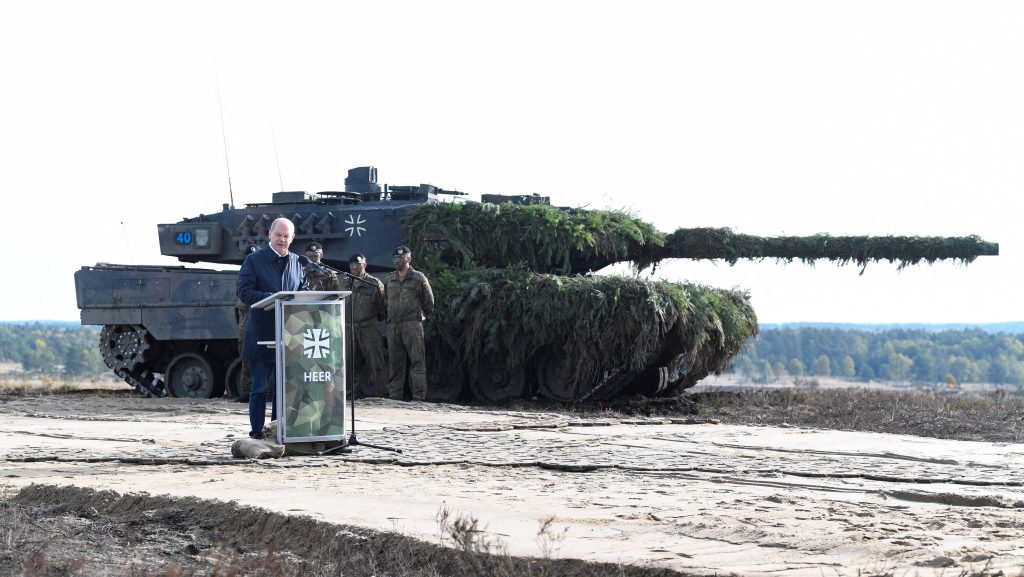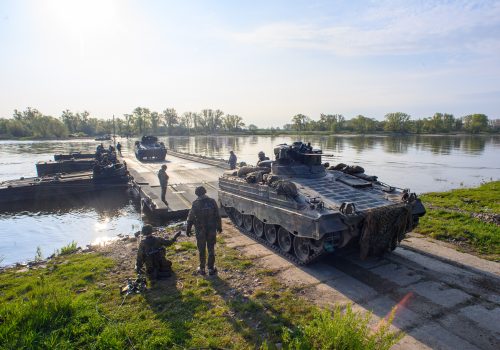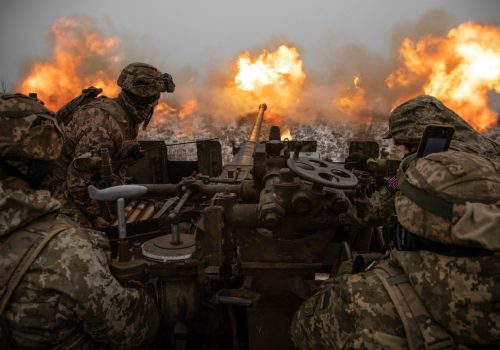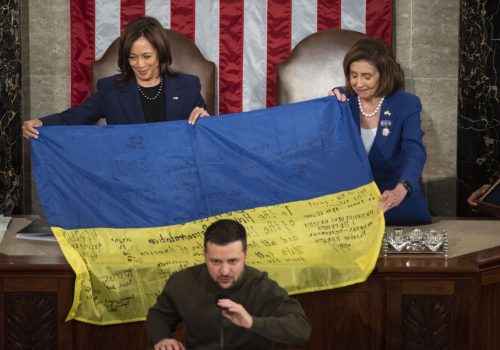European and US defense leaders met at Ramstein Air Base in Germany on Friday and, in the end, did not reach an agreement to send German-made Leopard 2 tanks to Ukraine. What this decision means for Ukraine on the battlefield is yet to be seen. What it reveals about the rest of Europe, however, is already clear: There are persistent and stark divisions on end goals for the war. A recent conference hosted by the Atlantic Council and the Konrad-Adenauer-Foundation in Stockholm investigated the roots of the divergent views among Western capitals over what should be achieved in Ukraine and how.
In general, two schools of thought have emerged on Ukraine. The first is held by the Baltics, Nordics, Poland, and other eastern European states, and it is the belief that Russia needs to be decisively defeated militarily. Russian President Vladimir Putin, the thinking goes, needs to be denied the opportunity to spin a narrative that can keep Russian imperialism alive. It is only after Russia gets rid of its “imperial temptation,” argued former Swedish Prime Minister Carl Bildt, that Moscow will be able to “develop in harmony with all of its neighbors and all of Europe.” The second school of thought, held by Germany, France, southern European states, and to an extent Washington, seeks to avoid escalation in the belief that a Putin cornered and in decline could lead to uncontrollable developments. Moreover, the second school views Russia as unavoidably Europe’s neighbor, a country that must be dealt with in one way or another.
This split in end-state goals of the war in Ukraine was termed the “regionalization of security optics” by Andrew A. Michta, an Atlantic Council nonresident senior fellow and dean of the College of International and Security Studies at the George C. Marshall European Center for Security Studies. The farther west one travels in Europe, the less of a threat Russia seems.
The bloc of nations in the first school of thought, geographically closest to Russia, views the West as “living under the umbrella of the Ukrainian armed forces,” said Michal Baranowski, director of the German Marshall Fund’s Warsaw office. What stands between Russia and the rest of Europe are Ukrainian soldiers and society. The umbrella is not a solution but simply buys Europe time. “The cost of supporting Ukraine might seem high,” said Swedish State Secretary for Development Cooperation Diana Janse, “but the costs of not resisting Russia would be exponentially higher.”
In a clear expression of this thinking, Sweden and Finland announced one day ahead of the Ramstein meeting that they would send their most advanced and largest military aid packages yet to Ukraine. These packages include the CV90 infantry fighting vehicle, Archer self-propelled artillery system, and four hundred million euros worth of other materiel. In doing so, the Nordic duo sent a clear signal to other European capitals on their stance on Ukrainian victory.
Particularly in the Baltic and Polish thinking, if Ukraine is not “armed to the teeth” by the West and capable of retaking its territory, including Crimea, then Russia would destroy Ukraine and ultimately the rules-based order, argued Sławomir Dębski, director of the Polish Institute of International Affairs. Ukraine retaking Crimea, he added, would leave no doubt that Russia had lost the war at enormous cost to its society and that Moscow would no longer play a major role in European affairs.
To ensure a Ukrainian victory that includes Crimea, NATO members need to move into wartime production of munitions, argued Michta. Western governments need to put in orders to industry, which will not produce munitions without contracts in hand. As Baranowski noted, it would be a moral failing for the West to “turn off the tap” of weapons and munitions when Ukraine remains willing to fight. Moreover, failing to restock Ukraine will leave the West facing harsh realities in a few short months. If the conflict freezes, Russia will reconstitute its forces and attack again, creating a “wider war in Europe,” Mictha warned.
The second school of thought on the end state in Ukraine, generally held by western and southern European states, holds that further military aid could lead to uncontrollable escalation. Indeed, to date, military support for Ukraine has been highly conditional. The West’s “boiling of the frog” approach, slowly sending more and more advanced weaponry with strings attached on how such weaponry can be used, naturally decides what Ukraine can and cannot do on the battlefield, argued Jana Puglierin, head of the Berlin office of the European Council on Foreign Relations. Such conditional support seeks to avoid escalating to a direct war between Russia and NATO.
German Chancellor Olaf Scholz has echoed this sentiment, for example, when speaking about going back to the old order with Russia. When eastern European countries hear such statements, they believe that Germany does not understand what is at stake. However, from a German perspective, Puglierin noted, it has been difficult to shift from generations being told “there is no military solution” to global problems to “there is only a military solution” in Ukraine.
This divide has resulted in consequences for relations between Berlin and its eastern and northern European neighbors. Helsinki is already thinking less about Berlin, said Hanna Ojanen, research director at the University of Tampere in Finland. Germany used to be a light house: a country to trust, to look to for leadership, and to “hide behind” when making political decisions. Now, Finland is taking decisions on its own “without waiting for Germany,” Ojanen explained.
Finland’s forward-leaning decision-making is one indication of waning German leadership in Europe, despite Berlin’s Zeitenwende—its foreign policy “turning point” announced by Scholz last year in the early days of Putin’s invasion. Germany’s old reflex of not going alone, seeking multilateral engagement, and refraining from military instruments to find solutions is still the default reaction to Russia’s war in Ukraine. Europe’s expectations may have been raised at first by the promise of Zeitenwende, and with it renewed German leadership. But Berlin is still viewed today as not doing enough, said Benjamin Tallis, senior research fellow at the German Council on Foreign Relations.
Continued European division over Ukraine has far-reaching consequences, Michta warned. If there is no clarity in Europe that Ukraine is fighting Europe’s war and that Ukraine belongs within European security parameters, then US attention might turn elsewhere. For the time being, the United States remains committed to Europe. However, Russia and Ukraine are only part of a bigger picture for Washington. Though the long-touted US pivot to Asia has yet to fully materialize, as both an Atlantic and Pacific power, the United States will increasingly focus on China. After decades of disarmament, Europe has a period of only about ten years in which the United States will bridge the gap in restocking depleted stockpiles, Michta explained. Europe has to make larger investments, and soon, to convince the United States to continue funding European security.
A central challenge to maintaining transatlantic unity is helping western European states understand the stakes in Ukraine. Bildt, a member of the Atlantic Council’s International Advisory Board, summed up the reality with his closing words at the Stockholm conference: “The stability of Ukraine is a precondition for the stability of all of Europe.”
Eric Adamson is a project manager at the Atlantic Council’s Northern Europe office in Stockholm.
Further reading
Fri, Jan 6, 2023
Experts react: Can new French and German weapons turn the tide in Ukraine?
New Atlanticist By
What do these additions mean for the battlefield? What do they signal about the positioning of France, Germany, and Europe as a whole in this protracted conflict?
Tue, Jan 17, 2023
How Europe can help Ukraine defeat Russia and win the peace in 2023
UkraineAlert By
Continued European support for Ukraine will be crucial in 2023 and must feature a combination of intensification and innovation if Vladimir Putin's invasion is to be decisively defeated, writes Andreas Umland.
Thu, Jan 12, 2023
The West reaps multiple benefits from backing Ukraine against Russia
UkraineAlert By
Ukraine is often viewed as being heavily reliant on Western support but the relationship is mutually beneficial and provides the West with enhanced security along with valuable intelligence, writes Taras Kuzio.
Image: German Chancellor Olaf Scholz delivers a speech in front of a Leopard 2 tank during a visit to a military base of the German army Bundeswehr in Bergen, Germany, October 17, 2022. REUTERS/Fabian Bimmer



